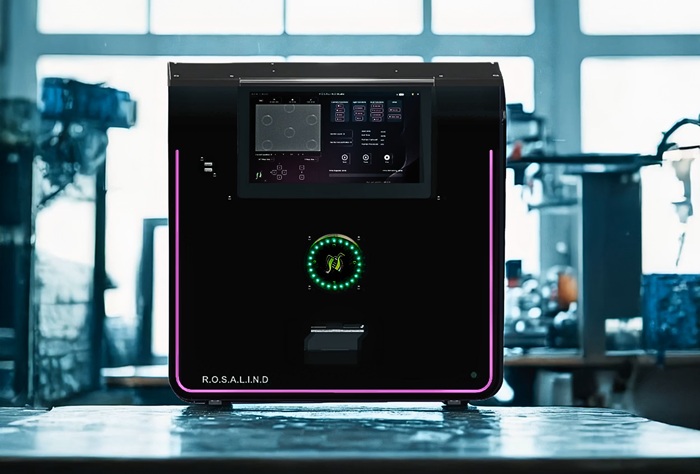Platelet Antibody Specificity Analyzed by Different Tests
|
By LabMedica International staff writers Posted on 09 Jun 2015 |

Image: Scanning electron micrograph of activated platelets (Photo courtesy of Bayer).
The detection of platelet antibodies plays a crucial role in the diagnosis of immunologic platelet disorders such as fetal/neonatal alloimmune thrombocytopenia (FNAIT) or refractoriness to platelet transfusions, influencing further therapeutic management.
The gold standard analysis for the determination of platelet antibodies, the “monoclonal antibody immobilization of platelet antigens” assay is restricted to specialized reference laboratories due to the laborious efforts involved and the consequent need for freshly prepared test platelet.
Hematologists at the Medical University of Graz (Austria) analyzed serum samples from 1,234 patients with a median age of 58.2 years and 573 were female and 661 male. The serum samples were tested for Human Leukocyte Antigen (HLA) or platelet-specific antibodies. The scientists routinely use two commercially available test methods, an antigen capture ELISA and a solid-phase assay. For the confirmation and specification of anti-HLA class I antibodies, a complement-dependent lymphocytotoxicity test is additionally performed.
All serum samples were analyzed by enzyme-linked immunosorbent assays (ELISA), either Lifecodes PAKPLUS or PAK12 (Gen-Probe; Waukesha, WI, USA), and by a solid-phase assay (Capture-P Ready Screen, Immucor Inc.; Norcross, GA, USA), and in specified cases by a specific lymphocytotoxicity test (LCT, Bio-Rad Medical Diagnostics GmbH; Dreieich, Germany). The LCT was performed in cases of clinically suspected or, by the described assays detected, HLA class I antibodies.
Platelet antibodies were detected in 366 of 1,234 samples (29.7%). In 70.3% concordant negative, but only in 8.4% concordant positive results were obtained with both the methods; 185 of 1,053 in the solid-phase assay negative samples were positive in the ELISA (15.0%). In samples positive in both methods, most antibodies reacted against HLA class I antigens. Glycoprotein (GP) specific platelet antibodies were more frequently detectable in the ELISA than in the solid-phase assay, whereas weakly positive results have to be interpreted cautiously.
The authors concluded that because ELISA, solid-phase assay, and LCT showed highly divergent results and only for detecting soluble platelet antibodies, and due to several limitations. The additional analysis by the “monoclonal antibody-specific immobilization of platelet antigen” (MAIPA) assay is highly recommended. The study was published on May 5, 2015, in the Journal of Clinical Laboratory Analysis.
Related Links:
Medical University of Graz
Gen-Probe
Immucor Inc.
The gold standard analysis for the determination of platelet antibodies, the “monoclonal antibody immobilization of platelet antigens” assay is restricted to specialized reference laboratories due to the laborious efforts involved and the consequent need for freshly prepared test platelet.
Hematologists at the Medical University of Graz (Austria) analyzed serum samples from 1,234 patients with a median age of 58.2 years and 573 were female and 661 male. The serum samples were tested for Human Leukocyte Antigen (HLA) or platelet-specific antibodies. The scientists routinely use two commercially available test methods, an antigen capture ELISA and a solid-phase assay. For the confirmation and specification of anti-HLA class I antibodies, a complement-dependent lymphocytotoxicity test is additionally performed.
All serum samples were analyzed by enzyme-linked immunosorbent assays (ELISA), either Lifecodes PAKPLUS or PAK12 (Gen-Probe; Waukesha, WI, USA), and by a solid-phase assay (Capture-P Ready Screen, Immucor Inc.; Norcross, GA, USA), and in specified cases by a specific lymphocytotoxicity test (LCT, Bio-Rad Medical Diagnostics GmbH; Dreieich, Germany). The LCT was performed in cases of clinically suspected or, by the described assays detected, HLA class I antibodies.
Platelet antibodies were detected in 366 of 1,234 samples (29.7%). In 70.3% concordant negative, but only in 8.4% concordant positive results were obtained with both the methods; 185 of 1,053 in the solid-phase assay negative samples were positive in the ELISA (15.0%). In samples positive in both methods, most antibodies reacted against HLA class I antigens. Glycoprotein (GP) specific platelet antibodies were more frequently detectable in the ELISA than in the solid-phase assay, whereas weakly positive results have to be interpreted cautiously.
The authors concluded that because ELISA, solid-phase assay, and LCT showed highly divergent results and only for detecting soluble platelet antibodies, and due to several limitations. The additional analysis by the “monoclonal antibody-specific immobilization of platelet antigen” (MAIPA) assay is highly recommended. The study was published on May 5, 2015, in the Journal of Clinical Laboratory Analysis.
Related Links:
Medical University of Graz
Gen-Probe
Immucor Inc.
Latest Hematology News
- MRD Tests Could Predict Survival in Leukemia Patients
- Platelet Activity Blood Test in Middle Age Could Identify Early Alzheimer’s Risk
- Microvesicles Measurement Could Detect Vascular Injury in Sickle Cell Disease Patients
- ADLM’s New Coagulation Testing Guidance to Improve Care for Patients on Blood Thinners
- Viscoelastic Testing Could Improve Treatment of Maternal Hemorrhage
- Pioneering Model Measures Radiation Exposure in Blood for Precise Cancer Treatments
- Platelets Could Improve Early and Minimally Invasive Detection of Cancer
- Portable and Disposable Device Obtains Platelet-Rich Plasma Without Complex Equipment
- Disposable Cartridge-Based Test Delivers Rapid and Accurate CBC Results
- First Point-of-Care Heparin Monitoring Test Provides Results in Under 15 Minutes

- New Scoring System Predicts Risk of Developing Cancer from Common Blood Disorder
- Non-Invasive Prenatal Test for Fetal RhD Status Demonstrates 100% Accuracy
- WBC Count Could Predict Severity of COVID-19 Symptoms
- New Platelet Counting Technology to Help Labs Prevent Diagnosis Errors
- Streamlined Approach to Testing for Heparin-Induced Thrombocytopenia Improves Diagnostic Accuracy
- POC Hemostasis System Could Help Prevent Maternal Deaths
Channels
Clinical Chemistry
view channel
Noninvasive Blood-Glucose Monitoring to Replace Finger Pricks for Diabetics
People with diabetes often need to measure their blood glucose multiple times a day, most commonly through finger-prick blood tests or implanted sensors. These methods can be painful, inconvenient, and... Read more
POC Breath Diagnostic System to Detect Pneumonia-Causing Pathogens
Pseudomonas aeruginosa is a major cause of hospital-acquired and ventilator-associated pneumonia, particularly in lung transplant recipients and patients with structural lung disease. Its ability to form... Read moreMolecular Diagnostics
view channel
World's First NGS-Based Diagnostic Platform Fully Automates Sample-To-Result Process Within Single Device
Rapid point-of-need diagnostics are of critical need, especially in the areas of infectious disease and cancer testing and monitoring. Now, a direct-from-specimen platform that performs genomic analysis... Read more
Rapid Diagnostic Breakthrough Simultaneously Detects Resistance and Virulence in Klebsiella Pneumoniae
Antibiotic resistance is a steadily escalating threat to global healthcare, making common infections harder to treat and increasing the risk of severe complications. One of the most concerning pathogens... Read moreImmunology
view channel
Blood Test Could Identify Colon Cancer Patients to Benefit from NSAIDs
Colon cancer remains a major cause of cancer-related illness, with many patients facing relapse even after surgery and chemotherapy. Up to 40% of people with stage III disease experience recurrence, highlighting... Read moreBlood Test Could Detect Adverse Immunotherapy Effects
Immune checkpoint inhibitors have transformed cancer treatment, but they can also trigger serious immune-related adverse events that damage healthy organs and may become life-threatening if not detected early.... Read moreMicrobiology
view channel
New UTI Diagnosis Method Delivers Antibiotic Resistance Results 24 Hours Earlier
Urinary tract infections affect around 152 million people every year, making them one of the most common bacterial infections worldwide. In routine medical practice, diagnosis often relies on rapid urine... Read more
Breakthroughs in Microbial Analysis to Enhance Disease Prediction
Microorganisms shape human health, ecosystems, and the planet’s climate, yet identifying them and understanding how they are related remains a major scientific challenge. Even with modern DNA sequencing,... Read morePathology
view channel
AI Tool Simultaneously Identifies Genetic Mutations and Disease Type
Interpreting genetic test results remains a major challenge in modern medicine, particularly for rare and complex diseases. While existing tools can indicate whether a genetic mutation is harmful, they... Read more
Rapid Low-Cost Tests Can Prevent Child Deaths from Contaminated Medicinal Syrups
Medicinal syrups contaminated with toxic chemicals have caused the deaths of hundreds of children worldwide, exposing a critical gap in how these products are tested before reaching patients.... Read more
Tumor Signals in Saliva and Blood Enable Non-Invasive Monitoring of Head and Neck Cancer
Head and neck cancers are among the most aggressive malignancies worldwide, with nearly 900,000 new cases diagnosed each year. Monitoring these cancers for recurrence or relapse typically relies on tissue... Read moreTechnology
view channel
Diagnostic Chip Monitors Chemotherapy Effectiveness for Brain Cancer
Glioblastoma is one of the most aggressive and fatal brain cancers, with most patients surviving less than two years after diagnosis. Treatment is particularly challenging because the tumor infiltrates... Read more
Machine Learning Models Diagnose ALS Earlier Through Blood Biomarkers
Amyotrophic lateral sclerosis (ALS) is a rapidly progressive neurodegenerative disease that is notoriously difficult to diagnose in its early stages. Early symptoms often overlap with other neurological... Read moreIndustry
view channel
BD and Penn Institute Collaborate to Advance Immunotherapy through Flow Cytometry
BD (Becton, Dickinson and Company, Franklin Lakes, NJ, USA) has entered into a strategic collaboration with the Institute for Immunology and Immune Health (I3H, Philadelphia, PA, USA) at the University... Read more
























